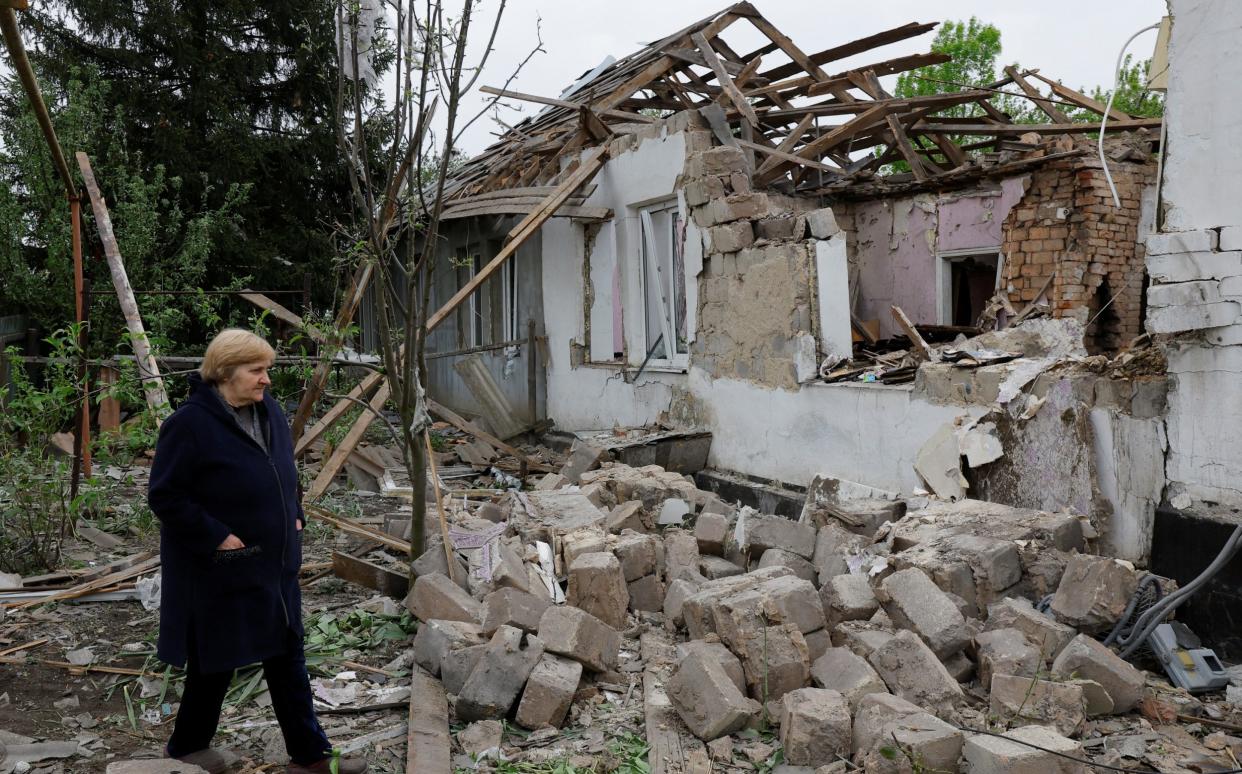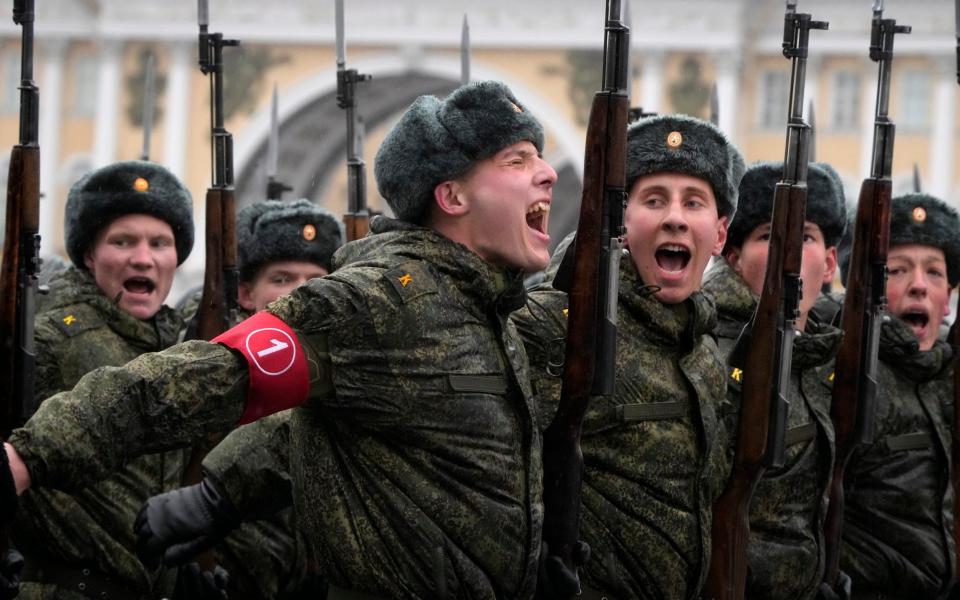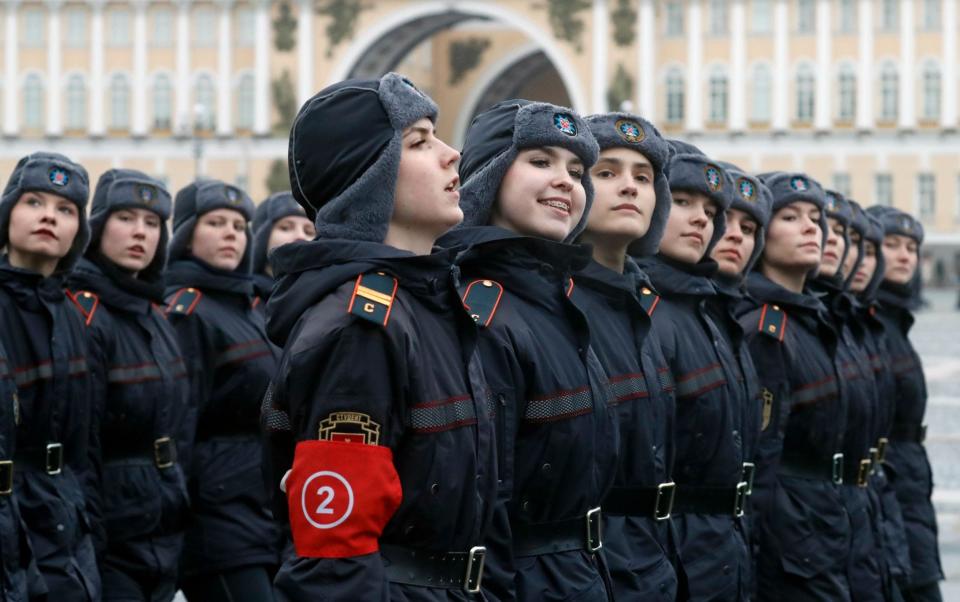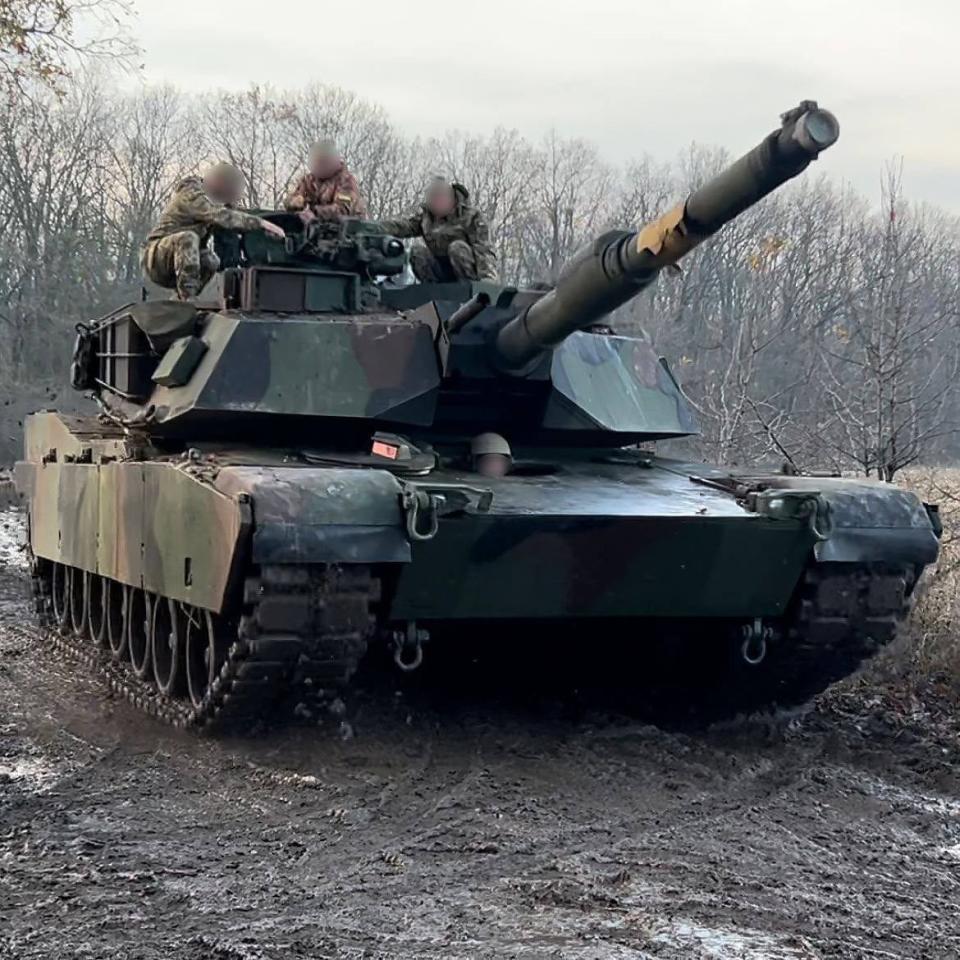100-mile US glide bombs fail in Ukraine

- Oops!Something went wrong.Please try again later.
Much-vaunted US-supplied glide bombs given to Ukraine “didn’t work” due to a combination of mud and Russian signal jamming, the Pentagon has admitted.
The long-range weapons, which were not officially named but have been identified online as Boeing’s Ground Launched Small Diameter Bombs (GLSDB), were sent to Ukraine to help them hit targets at twice the distance reachable by current rockets.
The delivery of the adapted bombs to Ukraine in late January was met with widespread enthusiasm, with military experts suggesting it could force Russia to relocate supplies farther from the front lines.
But William LaPlante, the Pentagon’s weapon’s acquisition chief, said: “We sent it to the Ukrainians. It didn’t work. It didn’t work for multiple reasons including EMI [Electromagnetic interference] environment, just really, dirt, and doing it on ground.”
“When you send something to people in the fight of their lives that doesn’t work, they’ll try it three times and then just throw it aside,” he added at an event at the Centre for Strategic and International Studies.
A precision-guided bomb with a 100-mile range, the GLSDB attaches to an M26 rocket and is cheaper than the current limited number of Army Tactical Missile System (ATACMS) rockets the US has sent.
Follow the latest updates below
01:26 PM BST
That’s all for today
Thanks for tuning in to today’s live blog. We’ll be back tomorrow to bring you all the latest from the war in Ukraine.
Key moments from today:
Vladimir Putin’s war in Ukraine is dependent on support from China, Antony Blinken, the US secretary of state, said during a visit to Beijing.
Russia has accelerated its advance west of Avdiivka over the past week, the Ministry of Defence (MoD) has said.
Advanced tanks donated by the US have been pulled from the front lines in Ukraine to avoid attacks by Russian drones.
Ukrainian strikes on the Zaporozhzhia nuclear power plant risk catastrophic consequences, Russian Defence Minister Sergei Shoigu said on Friday, according to the Russian state news agency TASS.
Belarusian leader Alexander Lukashenko has claimed that “several dozen” Russian tactical nuclear weapons had been deployed in Belarus.
The US is expected to announce a historic $6 billion in long-term military aid for Ukraine on Friday, according to US officials.
01:15 PM BST
Pictured: US failed glide bombs
01:10 PM BST
Russia’s Ukraine war would ‘struggle’ without China, says US
Vladimir Putin’s war in Ukraine is dependent on support from China, Antony Blinken, the US secretary of state, said during a visit to Beijing.
“Russia would struggle to sustain its assault on Ukraine without China’s support,” he told reporters after lengthy talks with Chinese president Xi Jinping and other officials.
Mr Blinken said that during the meeting he had reiterated “serious concern” about China providing components powering Russia’s war machine and said Beijing had previously shown willingness to positively influence Moscow’s actions, citing its stance on Russia’s nuclear threat.
His comments came after warning last week that China is now the “primary contributor” to Russia’s war in Ukraine, adding that Beijing’s supply of machine tools, semiconductors and other parts key to producing weapons is contributing to “the biggest threat to European security since the end of the Cold War”.
China has repeatedly claimed not to have provided weapons to either side in the conflict, stating that it is “not a producer of or party involved in the Ukraine crisis”.
01:01 PM BST
Russia accelerates advance near Avdiivka, says MoD
Russia has accelerated its advance west of Avdiivka over the past week, the Ministry of Defence (MoD) has said.
Moscow’s forces have have taken hold of a narrow passage of land deep inside Ukrainian territory to enter the town of Ocheretyne, located approximately nine miles north of Avdiivka - the city which Russia captured in February after months of intense fighting.
The MoD added that it is “highly likely” Russia has “taken control of several small settelements” in the region.
Its assessment came after the Institute for the Study of War yesterday announced that Russia has made “tactical gains” northwest of Avdiivka, but said that capturing Chasiv Yar, 31 miles to the north in Donetsk, is the main focus of Moscow’s offensive.
Taking Chasiv Yar would present an opportunity for Russia to “launch subsequent offensive operations against cities that form a significant Ukrainian defensive belt in Donetsk Oblast,” the ISW said.
12:39 PM BST
Ten wounded in Russian strikes
Russian guided bombs struck an industrial facility and a residential building in northeastern Ukraine, wounding at least four people, local officials said.
Three children and a woman were hurt when bombs hit a central part of the town of Derhachi in the Kharkiv region, Oleh Syniehubov, the local governor, said on the Telegram.
Elsewhere in Kherson, at least six people were injured after Russia bombing hit a shopping centre and a nursery, Oleksandr Prokudin, head of the regional military administration, said on Telegram.
Meanwhile, two bombs struck an industrial facility in Sumy to the south of Ukraine, regional authorities said.
11:58 AM BST
Ukraine withdraws Abrams tanks amid drone waves
Advanced tanks donated by the US have been pulled from the front lines in Ukraine to avoid attacks by Russian drones.
Abrams M1A1 battle tanks, which cost about $10 million each, are no longer safe from the growing threat of unmanned aerial vehicles that have changed the face of the war.
Five of the 31 tanks have already been lost to Russian attacks, US officials said as they admitted they had been forced to review tactics.
The proliferation of drones on the Ukrainian battlefield means “there isn’t open ground that you can just drive across without fear of detection”, a senior defence official said.
The tanks have been moved from the front lines while the US works with Ukrainians to reset tactics, said Joint Chiefs of Staff Vice Chairman Adm Christopher Grady.
“Now, there is a way to do it,” he said. “We’ll work with our Ukrainian partners, and other partners on the ground, to help them think through how they might use that, in that kind of changed environment now, where everything is seen immediately.”
Advanced and rudimentary drone warfare has revolutionised front-line conflict, forcing both sides to adapt. But the setback with Abrams comes as outgunned Ukraine is on the back foot, with Russia seizing a number of towns and villages in a series of successful advances this year.
11:11 AM BST
‘If you see an Atacm coming, all you can do is duck’
Long-range missiles from the West will allow Ukraine to shape the war “in much stronger ways”, Admiral Sir Tony Radakin, the head of Britain’s Armed Forces, has said.
For almost a year, the British Storm Shadow and its French twin, Scalp-EG, have been the favoured weapon for a campaign of Ukrainian deep strikes.
When the air-launched cruise missiles started arriving on the battlefield in May 2023, Kyiv unlocked a whole new set of Russian targets deep behind enemy lines.
Positions including those of warships, bridges and ammunition dumps that were once considered safely out of reach of Ukrainian fire were suddenly vulnerable.
10:46 AM BST
Pictured: Russian troops on parade


10:32 AM BST
Spain to send Ukraine Patriot missiles, reports suggest
Spain will send a “small number” of Patriot missiles to Ukraine in response to pressure from EU and NATO allies to provide more military aid to Kyiv, reports suggest.
Although Spain has ruled out sending any multi-million-euro Patriot launchers, government sources have said the country will supply missiles for the system.
“The transfer of a small number of missiles has come after the defence ministry refused to hand over to Ukraine the battery it has had deployed since 2013 on the Turkish-Syrian border,” the sources told El Pais.
“It will be a very limited number, as the Spanish war reserve is around 50 units and interceptors are very expensive.”
President Volodymyr Zelensky told Nato members earlier this month that Ukraine needed at least seven of the anti-aircraft defence systems to counter Russian air strikes, which have growing in intensity in recent months.
Spain has three Patriot batteries which it purchased second-hand from Germany in 2004 and 2014, El Pais said.
10:19 AM BST
Analysis: What has Ukraine pulled its Abrams tanks?
Modern battle tanks are weapons of shock and awe. They are best used manoeuvring around the battlefield at speeds of up to 50mph and delivering devastatingly accurate strikes with their 120mm cannons.
But in Ukraine they have been deployed on the frontline more as mobile pillboxes or as 60-ton sniper rifles.
This is why it should come as no real surprise that Ukrainian tank crews are pulling their American-made Abrams from frontline action.
Five of the 31 donated to Kyiv by Washington have been damaged, largely by Russian drones that hover over the battlefield seeking prized targets to strike. There is no greater prize for Moscow than an American, British or German-made tank.
These Nato-standard tanks are no more susceptible to drones than their Soviet-era counterparts. The Western models in fact offer better all-round protection. However, they were designed in an era when drone warfare, especially first-person view systems that are used to dive-bomb RPG munitions into targets.
It is therefore likely that Ukraine has opted to withdraw what is remaining of its fleet of Abrams to first modify them with drone protective cages and armour, just as the Russians have been doing, and secondly waiting for more ideal conditions for the tanks to be used.
Heavy, Western tanks operate much better hunting in a pack, supported with artillery and aerial fire, something in short supply for the Ukrainians. With the US package of aid promising more 155mm shells and the introduction of F-16 fighter jets incoming, the Abrams might just be offered better conditions to be used in genuine combined arms warfare to punch through Russian lines.
09:57 AM BST
Ukrainian strikes on Zaporizhzhia nuclear plant risk catastrophe
Ukrainian strikes on the Zaporozhzhia nuclear power plant risk catastrophic consequences, Russian Defence Minister Sergei Shoigu said on Friday, according to the Russian state news agency TASS.
Mr Shoigu was also cited as saying that foreign advisers were helping Ukraine prepare acts of sabotage on Russian territory. He did not provide evidence to back up his words.
Russia and Ukraine accuse each other of reckless military behaviour when it comes to the nuclear power plant.
The claims are yet to be independently verified.
09:37 AM BST
Abrams tanks in action
When US Abrams tanks set foot on the battlefield they were described by experts as perfect for the Ukrainian army.
They pointed to its strong armoured protection, swift mobility and heavy firing capabilities.
The 120mm smooth bore stabilised main armament is capable of taking out Russian tanks at a range of 3kms, when the Russian guns are effective at roughly half this distance.
In addition, it has a 50 calibre heavy machine gun which is devastating against infantry and drones.
Find more about the tanks below:
09:18 AM BST
US drones seek to level playing field with Russia
News that Ukraine is sidelining Abrams tanks comes as the US marks the second anniversary of the Ukraine Defense Contact Group.
The group is a coalition of 50 countries that meets monthly to identify Ukraine’s needs and where to find needed ammunition, weapons or maintenance to keep their troops equipped.
Recent aid packages - such as the $1bn of military assistance pledged by Joe Biden this week - also reflect a wider reset for Ukrainian forces in the evolving fight.
The announcement of more aid from the US - totalling $6bn - is set to be announced today.
US officials have said it will include much sought-after munitions for Patriot air defence systems.
Recently the battleground has changed in Ukraine, with the use of Russian surveillance drones and hunter-killer drones making moving without detection more difficult.
The new package will seek to remedy this, emphasising counter-drone capabilities, including .50-caliber rounds specifically modified to counter-drone systems; additional air defences and ammunition; and a host of alternative, and cheaper, vehicles, including Humvees, Bradley Infantry Fighting Vehicles and Mine Resistant Ambush Protected Vehicles.
08:59 AM BST
Ukraine pulls back Abrams tanks
Advanced tanks donated by the US have been pulled from the front lines in Ukraine to avoid attacks by Russian drones.
Abrams M1A1 battle tanks, which cost about $10 million each, are no longer safe from the growing threat of unmanned aerial vehicles that have changed the face of the war.

08:46 AM BST
Ukrainian minister detained over suspected corruption
Ukraine’s Agriculture Minister Mykola Solsky was detained after being named a formal suspect in a multimillion-dollar corruption inquiry, prosecutors said Friday.
Blighted by severe corruption scandals since the fall of the Soviet Union, Kyiv has pledged to bolster its anti-graft efforts as part of its bid for European Union membership.
Mr Solsky was accused of illegally seizing land worth more than $7 million when he was the head of a major farming company and a member of parliament.
An anti-corruption court ordered him to be held in custody until June 24, prosecutors said. Bail was set at 75.7 million hryvnias ($1.9 million).
08:29 AM BST
Lukashenko claims ‘several dozen’ Russian tactical nuclear weapons deployed in Belarus
Belarusian leader Alexander Lukashenko has claimed that “several dozen” Russian tactical nuclear weapons had been deployed in Belarus.
Russia’s Tass news agency said the move was part of an agreement jointly announced last year with Russian President Vladimir Putin.
It follows warnings made by Mr Lukashenko that Belarus is facing grave threats internally and externally that have required it to change its security posture, meaning it must align with Russia further.
08:12 AM BST
Ukraine Eurovision due travel to compete
Ukraine’s Eurovision competing duo left the country on Thursday to chase their dream in Malmö, Sweden.
The female duo of rapper alyona alyona and singer Jerry Heil are the country’s nomination for the pan-continental music competition.
“We need to be visible for the world,” Ms Heil told The Associated Press.
“We need to show that even now, during the war, our culture is developing, and that Ukrainian music is something waiting for the world” to discover, she added.
alyona, who spells her name with all lowercase letters, said: “We have to spread it and share it and show people how strong (Ukrainian) women and men are in our country.”
Ukraine has long used Eurovision as a form of cultural diplomacy, a mission that became more vital after Russia’s invasion.
Ukraine’s Eurovision win in 2022 brought the country the right to host the following year, but because of the war, the 2023 contest was held in Liverpool.
07:54 AM BST
US set to announce ‘historic’ £6bn aid deal
The US is expected to announce a historic $6 billion in long-term military aid for Ukraine on Friday, according to US officials.
The new funding - the highest amount of Ukraine Security Assistance Initiative (USAI) aid sent to date - is set to include an array of munitions for air defence.
They will include the much sought-after munitions for Patriot air defence systems.
Also on the list are the National Advanced Surface to Air Missile System (NASAM) and the High Mobility Artillery Rocket System (HIMARS), as well as the Patriot munitions, Switchblade and Puma drones, counter-drone systems and artillery.
Defense Secretary Lloyd Austin is expected to make the announcement in a virtual meeting on Friday of defence officials from Europe and around the world to discuss international aid for Ukraine.

